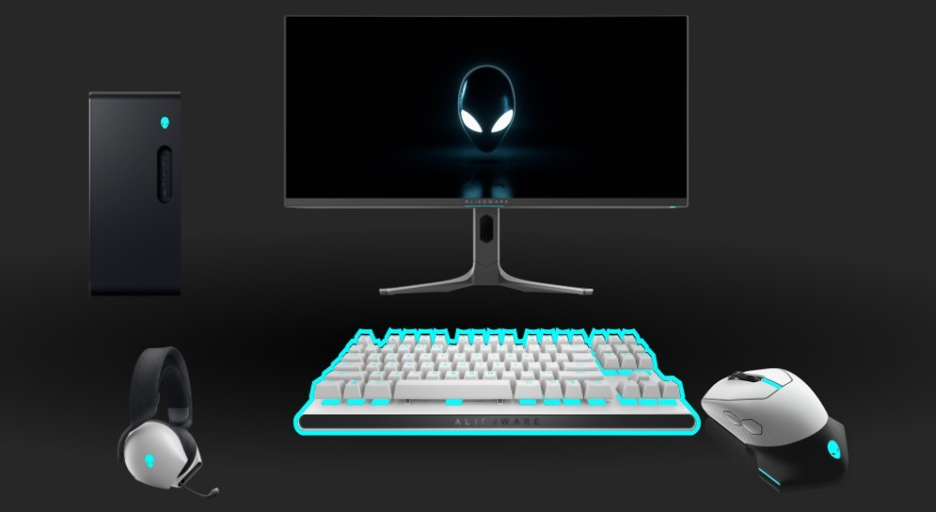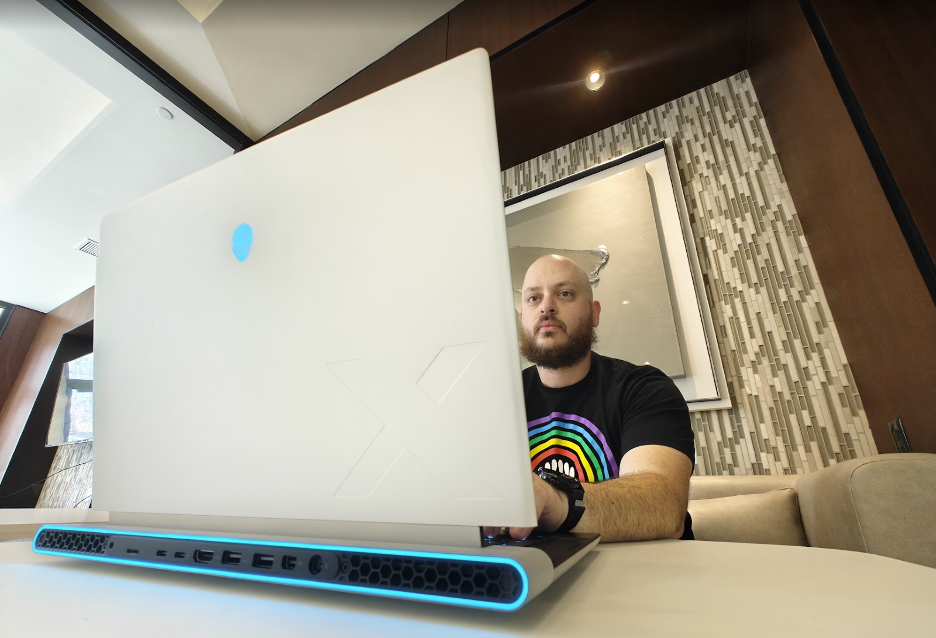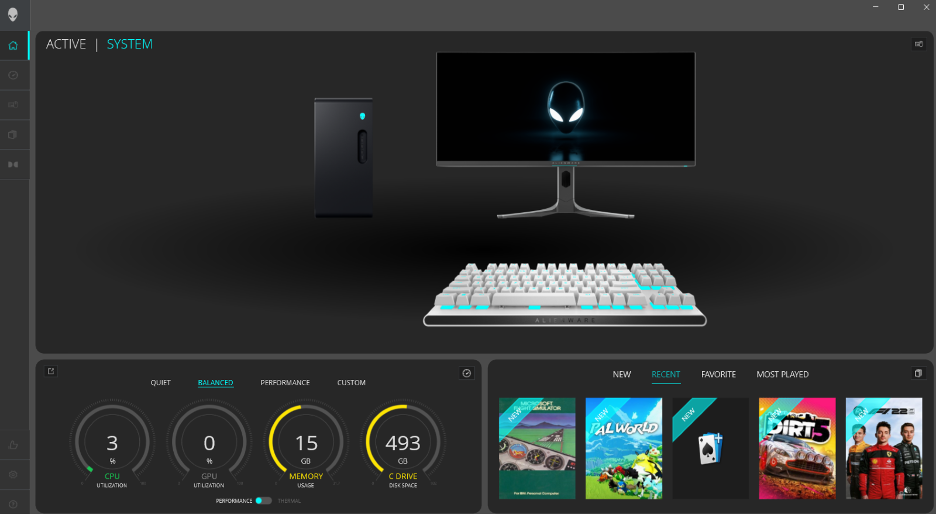
Alienware is now a complete gaming brand with a full lineup of laptops and desktop PCs, plus peripherals spanning the range from keyboards to headsets to top-tier monitors. Alienware has been a premium PC brand for quite some time, especially thanks to its close partnerships with AMD, Intel, and Nvidia. However, the gaming market has grown considerably with new entrants, and many of them have built robust gaming businesses of their own. However, very few of them have filled out a complete ecosystem of hardware and software to create a cohesive experience for gamers like Alienware has.
The PC: Laptop and Desktop
At the core of the gaming experience is the PC; whether that PC is a desktop or a laptop should be mostly irrelevant to the gamer. The Alienware buyer is buying an experience, including pre- and post-sales support. Alienware is always among the first to access the newest CPU and GPU technologies and it goes the extra mile, especially on laptops, to optimize cooling.
Recently I’ve had the opportunity to test Alienware’s x16 R1 and Aurora R16 PCs, each of which has unique value propositions. The x16 is Dell’s first 16-inch gaming notebook; the company has since released an updated version—the x16 R2—at this year’s CES. What sets the X-Series apart from the rest of Dell’s lineup is that it takes advantage of all the latest CPU and GPU technology and performance while still offering a portable form factor with premium materials. The x16, for example, ships with the top end of Intel’s mobile CPUs while also packing an NVIDIA RTX 4090, which enables incredibly high frame rates on the 1600p 240 Hz G-Sync display. This is possible thanks to Dell’s latest cooling technology and the latest in platform and thermal optimizations from AMD, Intel, and NVIDIA.
I was highly impressed with the x16 and loved its portability and the performance it delivered from such a thin profile. I am also happy to see that Dell has broadly adopted GaN chargers, which help reduce the size of the bricks used to accompany high-end gaming notebooks. One thing I wish Alienware would bring back is full-size memory card slots instead of MicroSD slots, but that comes down to personal preference, because I also like to use my gaming laptops as mobile workstations for photo and video editing.

The Aurora R16 is Alienware’s reimagination of its entry-level desktop. The R16 is a major departure from the R15 in many ways, looking to approach gamers at a more accessible price point while still offering the performance of a high-end solution. The Aurora R16 claims a 40% improvement in airflow, which is noticeable given how quietly it runs. My test machine came configured with an RTX 4090, which is genuinely impressive when considering the chassis’s compact size. I think Alienware did a great job overall with this system, although I’d like to see them put in more lighting, including on the recessed front I/O ports and the side honeycomb grill. I really liked how Alienware improved the cooling on the front of the case while still having a cool-looking light loop. (I would have liked to see that design element made symmetrical on both sides of the case.) Minor nitpicks aside, I think that the R16 is a really well-positioned system to enable a gamut of fun experiences for gamers looking for a complete and balanced system.
I used the Aurora R16 with Alienware peripherals, including the TKL keyboard, wireless headset, and mouse. I think Alienware should offer these peripherals dongle-free with its own systems, which it currently doesn’t. That means you will unnecessarily lose a few USB ports to first-party peripherals. I believe that having integrated low-latency peripheral connectivity is crucial for improving the ecosystem experience and the “better together” story, and could even be an aspirational play to attract gamers who want to buy an Alienware system but can only afford the peripherals at first. Even so, I am quite pleased with all the I/O that Alienware has put on the Aurora R16 compared to some other tier-one OEM systems I have tested. In addition to the peripherals already mentioned, I connected this system with Alienware’s coveted 34-inch curved OLED gaming monitor, and everything worked together extremely nicely. I was also impressed with how quickly the R16 booted to log in—faster than my AMD or Intel PCs that I’ve built myself, usually within about 10 seconds. This is important when you consider that people want to start gaming as quickly as possible—one of the key reasons why consoles exist.
The Monitor
Dell has the number-one market share in monitors, and last year’s 34-inch curved QD-OLED gaming monitor (AW3423DW) was received by many as the best gaming monitor on the market. This monitor paired extremely well with the Aurora R16 and other peripherals; thanks to Alienware Command Center, they all synced with one another, and all their settings including RGB lighting could be controlled from a single software console. It would be nice to manage monitor settings for G-Sync, color profiles, and so on from the Alienware Command Center like you can for other Dell products with the Dell Display Manager.
Dell was the first to market with a QD-OLED monitor, and this year it followed up with a 4K 240 Hz monitor featuring the next generation of QD-OLED panels. That said, it will be interesting to see how Alienware and Dell will compete with the plethora of new monitors that have the same panel. One important thing to consider is Alienware and Dell’s 3-year warranty and dead pixel and burn-in policy, which is unmatched by its competitors. In general, QD-OLED monitors are a double-edged sword because they are so rich in color and fast in response time that they render pretty much everything else inferior. So, I’m glad that Alienware has helped popularize Samsung’s panel technology to the point where it is becoming mainstream for premium monitors.
(For more of my thoughts on recently released monitors along with other products, check out this piece about Alienware at CES 2024 and this one about Dell at CES 2024.)
The Peripherals
All major PC OEMs have gone after the peripheral business, with companies like HP acquiring established brands such as HyperX. Alienware took the homegrown approach and partnered with e-sports outfit Team Liquid to better understand exactly what kinds of gaming peripherals its customers might want at the highest levels of competitive gaming. Using the resulting high-quality peripherals such as the AW720H headset, AW620M mouse, and AW420K keyboard was a great experience. The peripherals felt high-quality, gamed well, and were easy to keep synced and updated seamlessly with the latest firmware. My only gripe is the lack of integrated low-latency wireless connectivity for all these peripherals, which would make the experience even better. I have my own peripherals for my other PCs, and I was impressed with the comfort of all these devices. I could easily see them being competitive in the marketplace, especially when bundled with an Alienware system.

Alienware Command Center
The Alienware Command Center brings together much of what the Alienware brand hopes to accomplish by marrying its breadth of hardware with polished and complete software solutions. Right now, the core function of the Alienware Command Center is managing system appearance and performance. I like how easy it is to change between the different performance profiles and even create custom profiles as I see fit. That said, I have mostly run this system on balanced mode or performance mode and didn’t notice much of an audible noise difference.
Alienware has also added the ability to launch games directly from the Alienware Command Center, which regularly scans for new games to make them easier to find and launch. Using Alienware Command Center used to be a painful experience on Alienware laptops, but since version 6.0 launched last year, it has become much more enjoyable to use. As mentioned above, I would love to see it incorporate more functionality, for example to manage monitor settings.
Wrapping up
Across its desktops, laptops, monitors, and peripherals, Alienware is now built with a more cohesive design and experience. The Alienware x16 and 34-inch QD-OLED are not only at the absolute bleeding edge of what’s possible, but also helping to explore what it means to deliver a cohesive hardware and software experience that makes gaming more enjoyable. The experience has had such a profound impact on me that I have decided to make the Aurora R16 with the 34-inch QD-OLED my primary gaming setup. Alienware still has room for improvement, as all OEMs do, but I am happy to see how far the brand has come and where Dell is taking it.






















































































